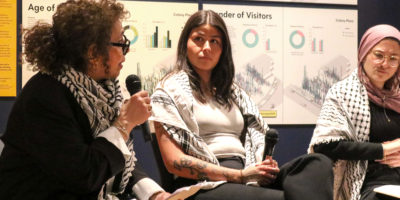By Wayne Seto
Tough guy Alick To is in the fight of his life. He’s up against the biggest, baddest bully he’s ever faced and he’s trying not go get trounced. He punches, kicks and stabs but to no avail. The evil boss has kicked his ass and taken his life. He’s dead, but not for long. To pops another quarter into the video game and comes back to life, ready for another go at his favourite game, Tekken, at his favourite arcade, Funland.
Although Funland is at Ryerson’s doorstep and Sega City Playdium is one hour away in Mississauga, Funland and Playdium are worlds apart in their conception of the best games. Video games are re-emerging as a popular form of entertainment thanks to new technology by big companies like Sega.
Funland has always been the video game and pinball Mecca of downtown. The moment you enter the Yonge Street arcade, your senses are bombarded with sights and sounds which seem downright alien. With its decaying ‘70s decor and the grunting and screaming of virtual martial arts fighting games, the grand old arcade contains pieces of gaming history.
The truly eclectic atmosphere cannot be found in any of the new arcades. There is , for instance, a vintage shooting gallery in the back room equipped with wooden guns and moving targets.
Funland is owned by Stan Budd. In business for 30 years, he owns other arcades along Yonge Street. Most of the time he sits in his office making phone calls to his West Coast distributor to find out which new games will earn him a profit and which ones will just sit and collect dust. He knows full well that fighting games are his big money makers these days.
“It seems to be what our market enjoys,” says Budd, referring to his customers, mostly men aged 18 to 35. “Maybe the downtown is a little violent,” he adds.
Ever since the release of Street Fighter 2 in 1991, violent, one-on-one fighting games have salvaged an industry that was floundering during the late ‘80s and early ‘90s.
But all the uppercuts, fireballs and six-button joystick configurations fighting games offer are of primary interest only to serious, habitual gamers. The eccentric atmosphere and complex games force novice and casual players to different arcades.
Many manufacturers are interested in attracting the occasional arcade player with games that don’t require much skill. Playdium, located by the Square One shopping mall in Mississauga, showcases these low-skill games. You won’t find Mortal Kombat or Street Fighter as the main attractions — here all the fighting games are tucked away in a corner. Instead, you will find a new breed of arcade games, simulators that shake, steer and shoot. Playdium has 33,000 sq. ft. of top-of-the-line adrenaline-rushing arcade simulators as well as real outdoor sports like miniature golf, go-karts and batting cages. There’s also a fully-licensed bar for adult players.
Unlike Funland, the decor is ultra-modern. Players are treated to club-style strobe lights and dozens of TV monitors hanging down like grapes from a vine.
Virtual experiences at Playdium also have surreal price-tags. Admission is free but to play Virtual Indy 500 for five minutes costs $3.50, Top Skater (virtual skateboarding) costs $1.75 and Hang Pilot (virtual hang gliding) costs $1.50. Instead of quarters, payment is made with a special debit card inserted into a card reader on each machine. Players can put as much money as they want on their card and when it’s used up they can add more at the cashier’s desk.
Frank Cain, Playdium’s general manager, says the games are expensive because of high production costs.
“It’s necessary to be bigger and better if we are to compete with the home market,” says Cain, referring to home video game systems like the Sony Playstation, Nintendo 64 and Sega Saturn.
“If we give players a place to play a game that they would never be able to have in their house, make it attractive to the eye and put it in an environment where they don’t feel threatened and that’s enjoyable, then they will come. The days of sleazy arcades are gone.”
Since many of Playdium’s visitors are first-time players, it’s the arcade simulators that make the most money. In fact, unlike Funland where fighting games are the cash cows, fighting games at Playdium barely pay for themselves. Instead, one of the top games is Jurassic Park: Lost World, a game where players sit down in a replica jeep from the movie and mercilessly shoot dinosaurs with a plastic infrared gun. This high-tech thrill ride and its ilk are what separate Playdium from arcades like Funland.
“Each game has to have a return on investment,” says Cain.
“The problem is, we can’t have too many [fighting games] because they’re not our largest source of profit. They get played by serious gamers but every time a new fighting game comes out, it gets expensive to keep replacing them. The bottom line here is if you put a gun or a steering wheel on it, it’s going to be successful.”
Rumour has it Sega and the Playdium Corp. plan to open nine more video theme parks across Canada before the next century, one of which will be located behind CityTV at Adelaide and John, a 10-minute walk from Funland.
Cain insists Playdium doesn’t want to create a bitter rivalry, they just want a piece of the pie. But Stan Budd wonders if another Playdium would work at that location.
“You can cater to your market but you can’t force your market,” says Budd.
“If those guys come downtown and put in all those big fancy games and if they’re going after the locals instead of the tourists, unless they go to 50-cent fighting games, then they’re in for a big surprise.”
Funland regular Femi Akimbode believes downtown Toronto is full of fighting game fans. Akimbode, who works at Square One, says arcade-goers are so into their hobby that they will even dress up as the characters from video games.
“There’s something of a cult following in T.O. for fighting games,” said the second-year York University computer science student.
“If there’s a new big game like Alpine Racer or Top Skater, it’s gonna be at Playdium which is more for novice players who don’t play a lot of games and are willing to spend a bit more money,” he says. “But Funland has all the action games you want to play.”
Alick To has been to both Funland and Sega and says he and his friends prefer fighting games over other kinds of games.
“For me, it’s a great stress reliever,” said the fourth-year Ryerson graphic communications management student.
“I can virtually beat up my opponent in my head without having to do any physical harm, which is great. The other good thing is that you get to meet people in competition, which is more interesting when compared to playing games by yourself.”
“SegaCity’s more elaborate and you can go with your friends. It’s more of an outing. At Funland, you just walk in and do your own thing.”
Cain says there are a lot of market research and demographics studies done before opening a large facility like Playdium.
With that in mind it’s probable that a downtown Playdium will have more fighting games than the Mississauga location. Will serious players flock to the new location to pay premiums for fighting games that Funland charges half the price for? Probably not. However, those of us out there who still can’t program a VCR might use the cheap thrills of virtual skateboarding or hang gliding to keep the Toronto winter blues at bay.











Leave a Reply